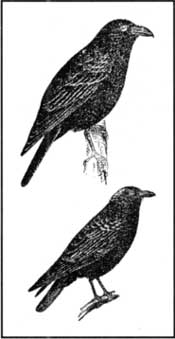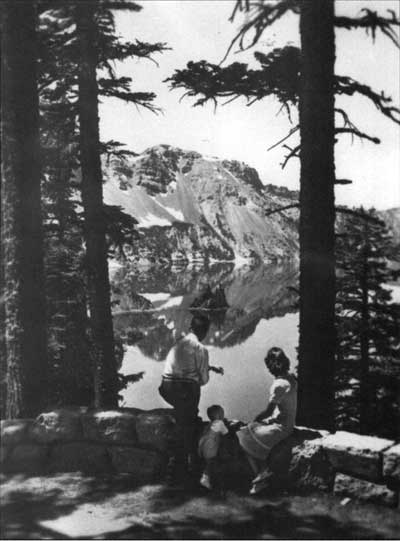Raven’s Call
Leftovers from last evening’s picnic just became a meal for ravens. They busily share with each other and fly to nearby trees to cache portions of food. Why would the first raven on the scene call others to share the find? They even allow a curious doe to approach and inspect the table, perhaps knowing that she will not be interested in chicken parts! The raven hops sedately but gives cautious, sideways jumps approaching the food. Their wings are half spread, poised for immediate takeoff. Only now do I remember that during the cold days of winter, a few opportunistic ravens are among the few commonly seen wildlife species in Rim Village, where they observe human visitors at lunch and play.
Ravens (Corvus corax) are the largest members of the crow family. This family also includes the smaller crows, as well as the more brightly colored nutcrackers, jays, and magpies. All are known for their learning abilities, especially in retrieving food caches. More than a hundred species are grouped into the family, one whose scientific name isCorvidae. Ravens are recognized by their large size—nearly twice that of the American crow. Whereas crows have square-shaped tails as well as blunt and splayed wings, ravens possess long and wedge-shaped tails, along with pointed wings which span up to four feet. There are no color differences with respect to gender among ravens, though males are slightly larger than females.
These birds historically followed the migrations of large game animals and tended to associate with predators such as bears, wolves, coyotes, and humans. Large predators not only killed game such as deer, elk, and caribou, but also were necessary to open or tear apart carcasses. Where humans subsisted as hunters, ravens frequented villages and played the role of scavengers. Ravens have disappeared from large areas of western and central Europe due to persistent persecution by farmers and gamekeepers. In contrast to crows, the raven has not adapted to urban areas and tends to be seen in the wilder portions of its former range. It still enjoys a wide geographical and ecological distribution (something that extends from the Arctic Circle to mountainous regions of Central America), however, and associates with humans in places where ravens have not been mistreated or continually harassed.
The raven occupies a prominent place in the lore of many cultures. To some Indian tribes of the Pacific Northwest, the raven is responsible for the creation of the earth, its moon, along with the sun and stars, Other groups have believed that ravens controlled or affected the weather. Associating ravens with death on the battlefield probably led to the assumption that these birds were somehow harbingers of doom. This comes through in western literature, where the hoarse croaking of ravens is often symbolic of evil and impending destruction. In William Shakespeare’s Macbeth, for example, the raven is the one who “croaks the evil entrance.” Edgar Allen Poe’s description of the raven is also ominous:
“Ghastly grim and ancient Raven wandering from the Nightly shore— Tell me what thy lordly name is on the Night’s Plutonian shore!” Quoth the Raven, “Nevermore.”
 Size comparison between the raven (top) and crow (bottom). Drawings by Cester Reed in Frank Chapman’s Color Key to North American Birds (New York: Appleton, 1912) p. 255. |
Next time you are on the rim and have the feeling you are being watched, you probably are. Ravens have prospered because they are exceptional observers with remarkable memories. They can successfully collate and retrieve information, while recognizing cause and effect sequences. Such ability assists the ravens in acquiring sustenance and allows them to feast on an amazing array of foods. It may be well to remember as we bear witness to ravens observing human activities in picnic areas, this is opportunistic behavior predating (by millennia) the sign reading, “Do not feed the wildlife.” This National Park Service policy nevertheless makes sense in light of human visitation to parks being comparatively heavy, and wildlife numbers relatively few, such that the potential exists for creating dependence on humans for food.
It is nearly 6 a.m. and from my viewpoint at Crater Lake Lodge, I see the sun rising above the northern edge of Cloud Cap. During the past hour prior to sunrise, the high ceiling of clouds remaining from yesterday’s lightning storm has been aglow with orange hues reflecting the lake’s quiet waters. Mirrored images of the inner caldera walls and Wizard Island appear as perfect, while the shoreline seemingly dissolves. Volcanic rocks below the west rim—the Watchman, Hillman Peak, Llao Rock—are awash with early sunlight that constantly changes the display. The few human visitors, so ephemeral amid this scene, try to record through cameras yet another sunrise on the edge of what was once called the Sea of Silence. It is now one month since summer solstice, when the sun shone at its northernmost point just to the east of Wineglass slide.
Just as I began to think about shorter days, my attention suddenly turned to the Rim Picnic Area where three ravens were loudly squawking. Their bold black forms dove and swirled amid the dark green foliage of the old mountain hemlocks. This time they seemed to be at play, indulging in aerial acrobatics. Their antics include nose-diving with wings closed, turning, tumbling, and even somersaulting, then gliding upside down. With voices deep and penetrating, the ravens command immediate notice and respect. A guttural croaking echoes through the light breeze this peaceful morning. What are they saying to one another? I believe these birds have the answers, but they are not talking to us!
Ron Mastrogiuseppe has listened to the birds at Crater Lake National Park since his first visit almost three decades ago.

View of Phantom ship from Kerr Notch. Oregon State Highway Commission photo, 1950.

